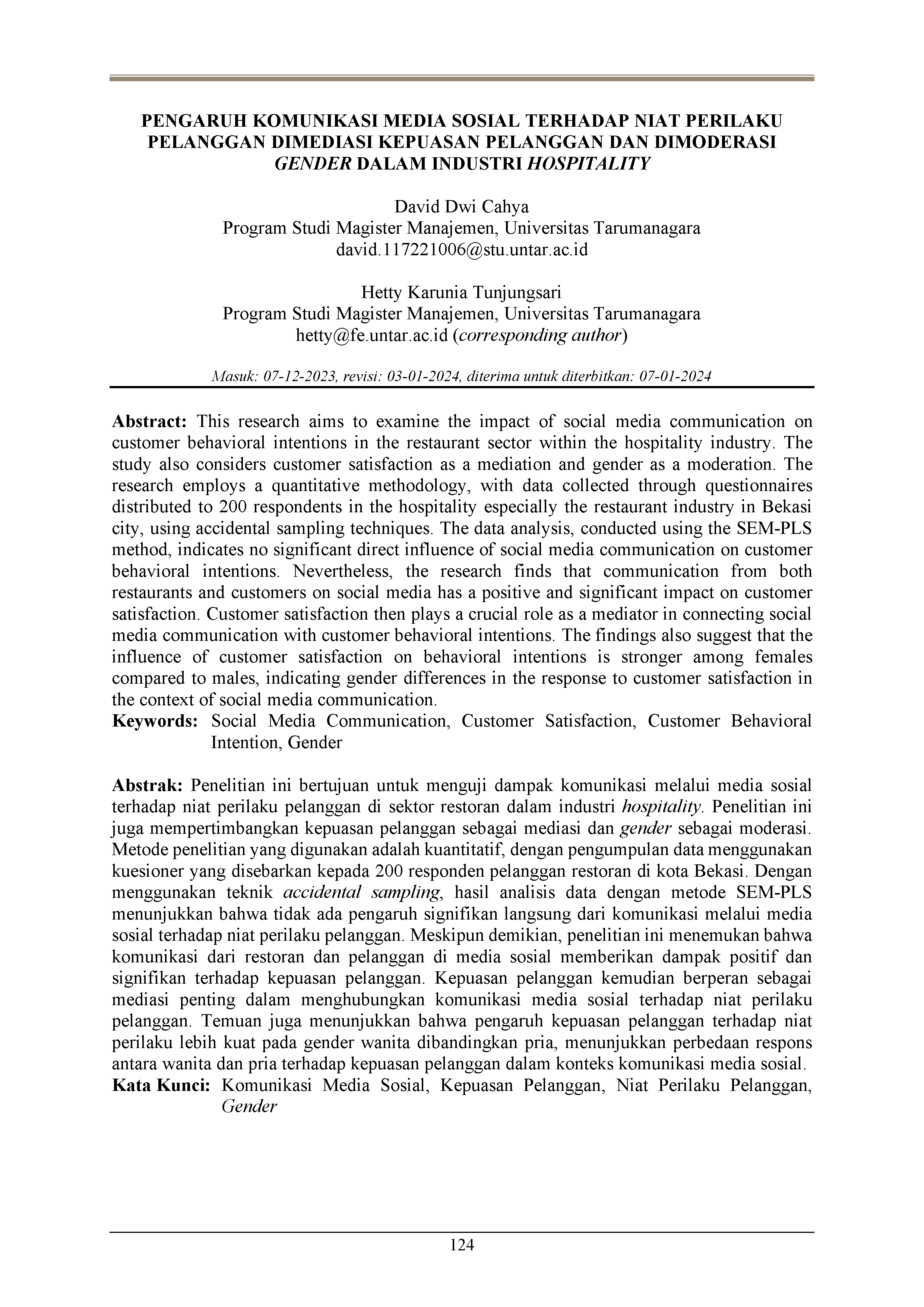Pengaruh komunikasi media sosial terhadap niat perilaku pelanggan dimediasi kepuasan pelanggan dan dimoderasi gender dalam industri hospitality
Main Article Content
Abstract
This research aims to examine the impact of social media communication on customer behavioral intentions in the restaurant sector within the hospitality industry. The study also considers customer satisfaction as a mediation and gender as a moderation. The research employs a quantitative methodology, with data collected through questionnaires distributed to 200 respondents in the hospitality especially the restaurant industry in Bekasi city, using accidental sampling techniques. The data analysis, conducted using the SEM-PLS method, indicates no significant direct influence of social media communication on customer behavioral intentions. Nevertheless, the research finds that communication from both restaurants and customers on social media has a positive and significant impact on customer satisfaction. Customer satisfaction then plays a crucial role as a mediator in connecting social media communication with customer behavioral intentions. The findings also suggest that the influence of customer satisfaction on behavioral intentions is stronger among females compared to males, indicating gender differences in the response to customer satisfaction in the context of social media communication.
Penelitian ini bertujuan untuk menguji dampak komunikasi melalui media sosial terhadap niat perilaku pelanggan di sektor restoran dalam industri hospitality. Penelitian ini juga mempertimbangkan kepuasan pelanggan sebagai mediasi dan gender sebagai moderasi. Metode penelitian yang digunakan adalah kuantitatif, dengan pengumpulan data menggunakan kuesioner yang disebarkan kepada 200 responden pelanggan restoran di kota Bekasi. Dengan menggunakan teknik accidental sampling, hasil analisis data dengan metode SEM-PLS menunjukkan bahwa tidak ada pengaruh signifikan langsung dari komunikasi melalui media sosial terhadap niat perilaku pelanggan. Meskipun demikian, penelitian ini menemukan bahwa komunikasi dari restoran dan pelanggan di media sosial memberikan dampak positif dan signifikan terhadap kepuasan pelanggan. Kepuasan pelanggan kemudian berperan sebagai mediasi penting dalam menghubungkan komunikasi media sosial terhadap niat perilaku pelanggan. Temuan juga menunjukkan bahwa pengaruh kepuasan pelanggan terhadap niat perilaku lebih kuat pada gender wanita dibandingkan pria, menunjukkan perbedaan respons antara wanita dan pria terhadap kepuasan pelanggan dalam konteks komunikasi media sosial.
Article Details

This work is licensed under a Creative Commons Attribution-NonCommercial-ShareAlike 4.0 International License.
This work is licensed under a Jurnal Manajemen Bisnis dan Kewirausahaan Creative Commons Attribution-ShareAlike 4.0 International License.
References
Byun, J., & Jang, S. (2019). Can signaling impact customer satisfaction and behavioral intentions in times of service failure?: Evidence from open versus closed kitchen restaurants. Journal of Hospitality Marketing and Management, 28(7), 785–806. https://doi.org/10.1080/19368623.2019.1567432
Flynn, N. (2012). The social media handbook: Rules, policies, and best practices to successfully manage your organization’s social media presence, posts, and potential. Wiley.
Ghozali, I. (2018). Aplikasi analisis multivariate dengan program IBM SPSS 25 (9th ed.). Badan Penerbit Universitas Diponegoro.
Greenberg, D. M., & Baron-Cohen, S. (2020). Empathizing-systemizing theory: Past, present, and future. In Encyclopedia of Personality and Individual Differences (pp. 1348–1352). Springer International Publishing. https://doi.org/10.1007/978-3-319-24612-3_893
Hair, Jr., J. F., Hult, G. T. M., Ringle, C. M., & Sarstedt, M. (2016). A primer on Partial Least Squares Structural Equation Modeling (PLS-SEM) (2nd ed.). SAGE.
Hair, J. F., Risher, J. J., Sarstedt, M., & Ringle, C. M. (2019). When to use and how to report the results of PLS-SEM. European Business Review, 31(1), 2–24. https://doi.org/10.1108/EBR-11-2018-0203
Hutasoit, C. S. (2011). Pelayanan publik: Teori dan aplikasi. MagnaScript.
Kaplan, A. M., & Haenlein, M. (2010). Users of the world, unite! The challenges and opportunities of social media. Business Horizons, 53(1), 59–68. https://doi.org/10.1016/j.bushor.2009.09.003
Kotler, P., & Keller, K. L. (2016). Marketing management (15th ed.). Pearson Education.
Li, C., & Bernoff, J. (2011). Groundswell: Winning in a world transformed by social technologies. Harvard Business Press.
Lihawa, N. X., & Tunjungsari, H. K. (2023). Customer loyalty pada industri penyedia layanan internet seluler di Jakarta: Customer satisfaction sebagai mediasi. Jurnal Manajemen Bisnis dan Kewirausahaan, 7(4), 826–837. https://doi.org/10.24912/jmbk.v7i4.25383
Llopis-Amorós, M. P., Gil-Saura, I., Ruiz-Molina, M. E., & Fuentes-Blasco, M. (2019). Social media communications and festival brand equity: Millennials vs Centennials. Journal of Hospitality and Tourism Management, 40, 134–144. https://doi.org/10.1016/j.jhtm.2019.08.002
Mangold, W. G., & Faulds, D. J. (2009). Social media: The new hybrid element of the promotion mix. Business Horizons, 52(4), 357–365. https://doi.org/10.1016/j.bushor.2009.03.002
OECD. (2007). Education at a glance 2007. https://www.oecd.org/education/skills-beyond-school/40701218.pdf
Peter, J. P., & Olson, J. C. (2010). Consumer behavior & marketing strategy (9th ed.). McGraw-Hill.
Putri, V. J. (2020). Pengaruh user-generated content (UGC) dan kualitas produk terhadap minat beli konsumen dapur Mbok Sarminah. Performa, 5(2), 95–102. https://doi.org/10.37715/jp.v5i1.1536
Qaiser, N., Sattar, N., Arshi, S., Asif, M. F., & Afridi, J. R. (2021). Impact of thriving on job performance, positive health and turnover intention: Consequences of thriving at workplace. International Journal of Information, Business and Management, 13(2), 97–107.
Riyanto, V., & Tunjungsari, H. K. (2020). Kualitas layanan dan nilai yang dipersepsikan terhadap niat pembelian pengguna jasa MRT dengan kepuasan pelanggan sebagai mediasi. Jurnal Manajerial dan Kewirausahaan, 2(3), 838–846. https://doi.org/10.24912/jmk.v2i3.9598
Schivinski, B., & Dabrowski, D. (2016). The effect of social media communication on consumer perceptions of brands. Journal of Marketing Communications, 22(2), 189–214. https://doi.org/10.1080/13527266.2013.871323
Sürücü, Ö., Öztürk, Y., Okumus, F., & Bilgihan, A. (2019). Brand awareness, image, physical quality and employee behavior as building blocks of customer-based brand equity: Consequences in the hotel context. Journal of Hospitality and Tourism Management, 40, 114–124. https://doi.org/10.1016/j.jhtm.2019.07.002
Xue, J., Zhou, Z., Zhang, L., & Majeed, S. (2020). Do brand competence and warmth always influence purchase intention? The moderating role of gender. Frontiers in Psychology, 11. https://doi.org/10.3389/fpsyg.2020.00248
Yasir, A., Abid, G., Afridi, J. R., Elahi, N. S., & Asif, M. F. (2021). Social media communication and behavioral intention of customers in hospitality industry: The mediating role of customer satisfaction. International Journal of Entrepreneurship, 25(4S), 1–15. https://www.abacademies.org/articles/social-media-communication-and-behavioral-intention-of-customers-in-hospitality-industry-the-mediating-role-customer-sat.pdf


